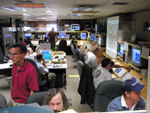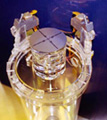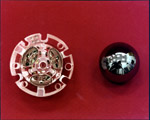WEEKLY HIGHLIGHTS FOR 20 AUGUST 2004:
GRAVITY PROBE B MISSION UPDATE

A little over four months into the mission, the spacecraft remains in excellent health, and all subsystems continue to perform well. The spacecraft’s roll rate remains stable at 0.75 rpm, and final testing of drag-free orbital flight and fine-tuning of the Attitude and Translation Control system (ATC) is continuing. All four gyros are now suspended in low-voltage science mode. All of their spin axes have been aligned with the science telescope’s sighting axis, which is locked onto the guide star, IM Pegasi. These alignments are in the process of being fine-tuned.
- Last weekend, we completed coarse spin axis alignment on gyros #2 and #4. On Monday, August 16th, ultraviolet light was beamed through fiber optic cables into the housing of gyro #2 to remove excess static charge on the gyro #2 rotor (sphere). Then, the suspension voltage for gyro #2 was reduced to 200 millivolts, the level required for science data collection. The following day, the same procedures were completed on gyro #4. Thus, by the middle of this past week, all four gyros were in the science mode configuration.
- About ten days ago, we began to notice that while in primary drag-free mode, the ATC was requiring more helium propellant than planned to counter an unexpected force along the spacecraft’s roll axis—that is, in the direction of the guide star. This past weekend, we switched to back-up drag-free mode on gyro#3, which gave a similar result. Over the past two days, we have completed two tests that have provided a solution for ensuring that the helium mass flow through the ATC system remains within required levels. By adjusting thruster biases, and by reducing the commanded helium flow, the amount of helium consumed by the ATC system is now less than the helium boiled away by the natural heat in the Dewar. As a result, the helium requirements of the ATC system will have no impact on the mission lifetime, thereby maximizing the science performance.
- Furthermore, in the process of performing these tests, we have determined that back-up drag-free mode is working very reliably, and thus we have re-selected back-up drag-free operation as the baseline mode for the Science Phase of the mission. We anticipate that our investigation and problem-solving efforts around this roll-axis force will take a few more days. During that time, we will continue testing back-up drag-free mode around gyro #3, as well as further fine-tuning the spin-axis alignment of the four gyros.
- In addition this past week, while optimizing the performance of the telescope system, we have found a small source of bias noise in the telescope detector output signal. Although it would probably have no effect on the science outcome, it seems prudent to eliminate this bias noise, especially since a simple adjustment will take care of it. We are planning to make this adjustment over the next two days.
- Finally, analysis of the gyroscope spin-down rate performance over this past week has shown that, under low-voltage, science mode suspension, the spin-down rate for all four gyros is less than 0.000001 Hz (0.00006 rpm) per hour. This means that it would take more than 7,000 years for one of our gyros to completely spin down. On Earth, we could only test the spin-down rates of the gyros in a high-voltage suspension mode, and based on these ground tests, the orbital spin-down requirement for the gyros was set at 2,300 years. We now see that the spin-down performance of the GP-B gyros in science mode is more than three times better than this requirement.




The spacecraft is being controlled from the Gravity Probe B Mission Operations Center, located here at Stanford University. The Stanford-NASA/MSFC-Lockheed Martin operations team is continuing to perform superbly.
Photos: The first photo, taken by GP-B Public Affairs Coordinator, Bob Kahn, shows GP-B team members communicating with the spacecraft from the GP-B Mission Operations Center here at Stanford. The drawing is a schematic diagram of a SQUID (Super-Conducting Quantum Interference Device) readout assembly. All the remaining photos are all taken from the GP-B Photo Archive here at Stanford University. They show an assembled gyro housing, including the fiber optic cables that shine ultraviolet light on the gyro rotors (spheres), a micro thruster, the image divider assembly at the top of the science telescope, and one half of a gyroscope housing with a gyro rotor. Click on the thumbnails to view enlarged copies of these images.
SWISS AMATEUR ASTRONOMER PHOTOGRAPHS GP-B GP-B SPACECRAFT IN ORBIT WITH GUIDE STAR IM PEGASI
To the right, is a thumbnail of a photograph of the GP-B spacecraft in orbit, along with the guide star, IM Pegasi. (Click on the thumbnail to view the photo at full size.) The photo was taken and emailed to us by Stefano Sposetti, a Swiss physics teacher and amateur astronomer. Stefano used a 40cm newtonian telescope, with a CCD camera and 20mm wide field lens attached to make this photo. He then sent us the two versions shown — the normal (black sky) version on the right, and an inverse version in which the constellation, Pegasus, the guide star IM Pegasi, and the path of the GP-B spacecraft are highlighted for easy identification on the left.

We are grateful to Stefano for sending us this wonderful photo. You can view other astronomical photos that he has taken on his Web page: http://aida.astronomie.info/sposetti. Following is Stefano's description of his photo:
In this picture one can see the quite dim GP-B satellite traveling from North (up) to South (down) direction. The bold line in the right part of the left image represents the satellite trail just before entering the earth shadow. (Every satellite becomes visible because it reflects the sunlight). The connecting lines show the constellation Pegasus. The small circle around the star is IM Pegasi, the guide star used by the spacecraft's telescope in his experiment! GP-B is a circumpolar satellite following a free fall trajectory about 640km above the earth surface. From my location the satellite passed that night at a maximum elevation of 87degrees, thus not exactly overhead. The brightness of the satellite was between 3mag and 4mag. The Moon, about in the last quarter phase, illuminated the sky and was a drawback for having a good signal/noise ratio of the satellite trace. I took this 60-seconds black and white CCD picture with a 20mm,f/2.8 lens on august 6 centered at 01:19:00 UT. North is up, East is left.
More links on recent topics
- Track the satellite in the sky
- Photo, video & and news links
- Build a paper model of the GP-B Spacecraft
- Following the mission online
- Our mailing list - receive the weekly highlights via email
- The GP-B Launch Companion in Adobe Acrobat PDF format. Please note: this file is 1.6 MB, so it may take awhile to download if you have a slow Internet connection.
Previous Highlight
Index of Highlights
